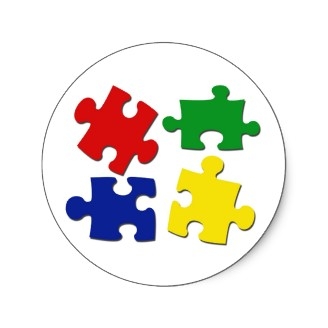Problem Solving Structure
Friday, January 31, 2014

Structuring is the most fundamental activity you can do to solve your problems. Most structuring tools, techniques, and methods follow simple step-by-step processes; with each step being a building block in the problem solving process. These steps are usually relatively easy to understand and use. Structured analysis is really pretty straight forward. Now, it's just up to you to crank it out.
In my last 4 blog posts, I've discussed the structure of my innovative method called the Problem Solving Matrix. I used the same structure to build my database application called MySolver™.
A Quick Review
To review, in my 10/30/13 blog post I've discussed the mirroring structure that exists between your Problem and your Solutions. Comparing these two structures will help you more effectively evaluate the essential structural elements and critical data relationships between your problem and your solutions.
In my last 3 blog posts, on 1/15/14, 11/30/13, and 11/12/13, I've explained the structuring of your Objective Data and Subjective Thoughts. Structuring your Objective Data will help you organize and manage your data. It will bring order to your problem solving process. Structuring your Subjective Thoughts will help you question your own thinking in a constructive and targeted manner.
There many other structuring tools besides my proprietary methods. I've included dozens of them in my website's Toolkit section. I'm going to discuss some of these classic problem solving tools below. I'll begin with decomposition.
Decomposing Your Problem

Decomposing your problem begins by identifying all the items that need to be considered in your analysis. Think of it like a puzzle, before you begin putting it together you should have all the pieces of the puzzle out on the table. You can start your structuring by listing all of your Factors.
The next step in structuring is to describe your data. Data does not describe itself. You need a system for describing your data to make your structuring efforts more efficient and effective. Determining Major Categories is an example of describing your data.
You'll also need to be able to manipulate your data. Examples of this are: Sorting and filtering.

The relationships between your factors are important, too. Examples of relationships can be seen in: groupings, variable dependencies, sequences, correlations, and cause & effect.
A good way to develop mental representations of your problem is to create visual representations of your data structure, such as a Mind Map.
Comparing structures can also be an effective problem-solving technique. We often use Analogies and Metaphors to see similarities and differences in the structural components between two objects.
Asking the Right Questions
Part of my training to become a forensic accountant was to learn interrogation techniques. I think, interrogation is an important part of problem solving. Of course, when dealing with your own problems there's only one suspect that needs to be interrogated. That's YOU! This is one of the reasons why I've developed my own methodologies and taxonomy for your self-examination. Specifically, I've created the term Interrogatory Dimension in order to bound your questioning activities.

Interrogatory words include the age-old journalist's list of: Who, What, When, Where, Why, and How. Plus, I've added add a couple more - From Where and To Where.
'From Where' and 'To Where' are modern forms of the archaic usages of 'whence' and 'whither'. I've included these because some aspects of time can not be accounted for by using just 'When'. Adding 'From Where' and 'To Where' establishes a completeness in questioning that better incorporates the time continuum.
Interrogatory dimensions are different from interrogatory words or interrogatory questions, in that they also include the answers to those questions. This is a very useful device because now you can describe all of your 'Objective Data' with an Interrogatory Dimension. This adds an important structural element to your analysis.

To make sure your analysis is complete, you should always ask each one of the eight types of interrogatory questions for each major category of your problem and for each possible solution. In-other-words, this is one of the methods you use to make sure your analysis is complete.
Preconceived Notions
Another term I've coined for my structured analytic methodology is Predisposition.
Predispositions are the personal thoughts that you are predisposed to. These include your: Intentions, Expectations, Assumptions, Intuitions, Opinions, Conclusions, Judgments, Beliefs, Hopes, and Gut Feelings.
Predispositions that are at the crux of your problem should be examined very carefully. It's important that you understand the mental models that are just below the surface of your predispositions. It's very possible that these unquestioned mental models hold the key to solving your problem.
Modifying Structures
The ability to modify existing structures should not be overlooked. This is especially important when you're examining a process. You can use the Sequential Attributes Matrix tool to modify a process. Here's the checklist for modifications: Substitute, Eliminate, Combine, Adapt, Exaggerate, Rearrange, and Reverse.
Hypothesis Generation
Creating solutions is at the heart of problem solving.
Once you've thoroughly examined your problem, it's time to fit hypothetical solutions to your evidence. Now, you're never going to have complete and perfect information to solve your problems. So, you need to determine what information will be useful to begin formulating hypotheses.
Here are a couple tools you can use to begin creating your hypotheses: Hypothesis Generator and Multiple Hypothesis Generator.
Structuring is the Key
Structuring is the most important concept in problem solving. The structures you develop become mental representations of your problem. It's the framework you build your knowledge upon.
There are lots of ways to structure your problem. The crucial decision for you, is to make sure that you use structuring tools, techniques, and methods to solve your problem.
by Keith Glein, Founder & CEO
